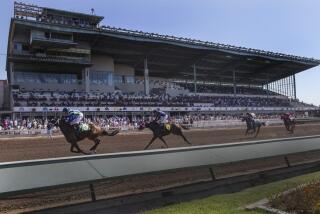Roundup Is Beginning of End for Herd
- Share via
THREE FINGERS GULCH, Ore. — You see them first.
A flowing line of horses gallops over the ridge. Behind them comes the helicopter, swooping down to 5 feet above the ground, banking side to side to keep the Three Fingers herd in a group.
This is the beginning of the end for these wild horses. Although they are federally protected--deemed “living symbols of the American West” by Congress 25 years ago--most are destined for restaurants in Europe and Asia.
*
We hear them coming.
Whinnies and clattering hooves. Snorts and grunts. The helicopter roaring behind them.
After 10 miles of running, the horses slow.
Hidden are about a dozen wranglers, paid about $300 for each horse they catch, and BLM staffers, paid to observe.
The herd nears the “Judas horse,” the one trained to lead them into captivity. Prompted by a slap, the Judas horse bolts into the open gates of a trap, and the herd follows. A hidden wrangler pulls a latch and the gate slams shut.
Stretched resources in the wilds led to the BLM’s 25-year-old program to capture the wild animals and put them up for adoption. By limiting herd sizes, the program aims to prevent starvation and further an ecological balance.
*
The Three Fingers herd ends up at the Palomino Valley Adoption and Placement Center in Reno. Separated by sex and age, the animals will live here at least 30 days. Stallions are gelded, treated for worms and vaccinated. They all receive freeze-brands on their necks.
Horses can be adopted at placement centers or at regional centers. Eventually, many end up at livestock auctions.
Shane Christian works the Wyoming auctions. He’s known as a “killer buyer,” meaning he buys for the slaughterhouses. He also buys BLM horses--”more than I’d like to,” he says.
*
“La viande de cheval, les fines bouches, n’en font qu’une bouchee,” (“Horse meat, the finest cuts, you can’t have just one bite,”) reads a poster at the Cavel West slaughterhouse in Redmond, Ore. It depicts a juicy hunk of horse meat on a fork heading toward a pair of women’s lips.
The killer buyers arrive at Cavel West regularly with loads of horses packed in trailers.
After being weighed, the horses are moved into muddy pens where they will spend hours, and, in some cases, weeks.
The ramp is narrow and steep. Inside the horse is shot in the forehead with a special gun, then it is bled by workers wearing white coveralls and rubber boots.
Horse carcasses are rolled into the boning room, where about 10 workers cut them into packageable chunks. The dark red meat is sealed in plastic bags, trucked to Chicago and flown to Europe.
Pascal Derde, a Belgian veterinarian who manages the place, says objections in the United States to slaughtering horses are simply “a cultural difference.” And, he says, there is nothing else to do with the horses.
More to Read
Sign up for Essential California
The most important California stories and recommendations in your inbox every morning.
You may occasionally receive promotional content from the Los Angeles Times.













